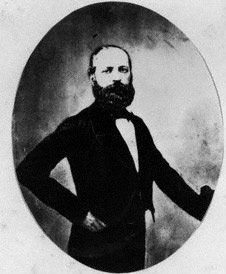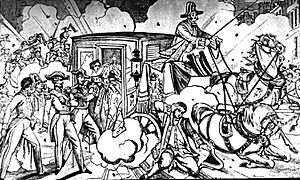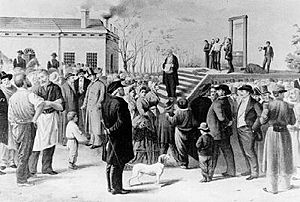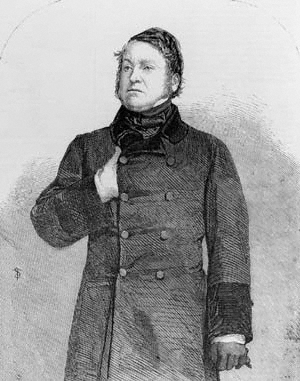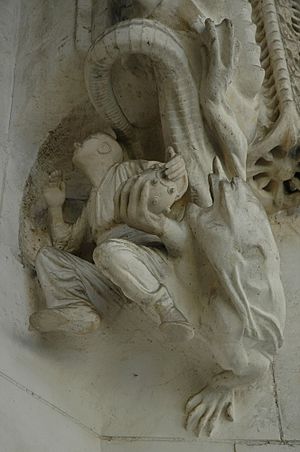Orsini affair facts for kids
The Orsini affair was a series of events that happened after an attack on Napoleon III in Paris on January 14, 1858. An Italian nationalist named Felice Orsini, along with others, tried to kill the French Emperor. This event had big effects on politics and relationships between countries.
In the United Kingdom, the government led by Lord Palmerston fell (meaning it lost power) within a month. Some trials of British radicals who supported Orsini ended without anyone being found guilty. This happened because many British people did not like the pressure France was putting on their country.
After the attack, Cavour, a leader in Italy, was able to make France an ally. This helped Italy in its fight for unification, known as the Risorgimento.
Contents
- Why the Attack Happened: Italian Unification
- Britain's Policy on Helping Refugees
- British Supporters of Orsini
- The Assassination Attempt
- Orsini's Arrest and Trial
- Impact on French Foreign Policy
- British Politics at Home
- Legal Cases in British Courts
- Landor's Legal Case
- People Inspired by Orsini
- See also
Why the Attack Happened: Italian Unification
Orsini and his group carried out the attack because they wanted to unite Italy. At that time, Italy was not a single country. Many people, especially thinkers and passionate nationalists, wanted to see Italy become one nation. They felt that Napoleon III was getting in the way of this goal. Some extreme groups even used violence to try and achieve Italian unification. A famous Italian leader living in London, Giuseppe Mazzini, organized a network of activists and people who raised money for the cause.
Britain's Policy on Helping Refugees
During this time, Britain had a policy of offering safety to political exiles and refugees. From 1823 until 1905, the United Kingdom did not try to control or register people who came into the country. The Orsini affair severely tested this policy. Besides Mazzini, other famous political figures like Alexandre Auguste Ledru-Rollin, Lajos Kossuth, and Alexander Herzen had moved to London. Napoleon III suspected that Mazzini and Ledru-Rollin were behind many attempts by Italians to kill him, and Orsini's attack was just the latest one. British law at the time treated conspiracy (planning a crime with others) as a minor offense, and there was no law to send people back to other countries for trial.
British Supporters of Orsini
In the year before the attack, Orsini was a popular speaker, giving talks across England and Scotland. Other main members of Orsini's group were also Italian and lived in England, where they worked as language teachers. Giovanni Andrea Pieri lived in Birmingham from 1853, and Carlo de Rudio was in Nottingham. Birmingham became an important place for their plan.
Orsini had spent time in England and made many friends. However, he had a big disagreement with a group of radicals, especially around William Henry Ashurst, in mid-1856. Orsini worked for Mazzini, but they had a serious argument over comments Orsini made about Emilie Hawkes, Ashurst's daughter. These comments were read by James Stansfeld, who was married to another of Ashurst's daughters. By 1857, Orsini was known to have left Mazzini's group.
Orsini's plan involved other radicals. He learned about explosives from William Mattieu Williams, whom he met in 1857. More deeply involved were Thomas Allsop and George Jacob Holyoake. Thomas Durell Powell Hodge, a follower of Orsini, was also involved, as was Simon François Bernard, a French doctor living abroad.
Allsop arranged for special "Orsini bombs" to be made by a company in Birmingham. Others tested these bombs in the countryside. Allsop also gave Orsini an old British passport to travel to France.
The Assassination Attempt
On the evening of January 14, 1858, Napoleon III and Empress Eugénie were on their way to the Salle Le Peletier theatre to see an opera. Orsini and his helpers threw three bombs at their carriage. The first bomb landed near the horsemen in front of the carriage. The second bomb hurt the horses and broke the carriage windows. The third bomb landed under the carriage and badly injured a policeman who was trying to protect the Emperor and Empress.
The attack killed eight people and a horse. Most of the damage hit the Emperor's military guards. About 150 people were wounded. The strong build of the carriage protected the Emperor and Empress. Orsini himself was wounded. He treated his injuries and went back to his home, where police found him the next day.
Orsini's Arrest and Trial
Orsini ran away from the attack scene but was arrested soon after. He was put on trial and sentenced to death. He left a detailed written statement and also sent two letters to Napoleon III. He was executed on March 13, 1858, along with Pieri, who had also planned to be part of the attack but had been arrested earlier. Camillo di Rudio, another attacker, was found guilty but his death sentence was changed to hard labor. Later, in the USA, he fought in the Battle of the Little Big Horn under Custer. Antonio Gomez, Orsini's servant, was also sentenced to hard labor. One of Orsini's letters to Napoleon was read in court by his lawyer. The second letter was officially published after his death.
Before the trials, in early February, a new minister was appointed in France. During his time in office, France saw a period of strict control. A new, harsh law was passed, and many people who disagreed with the Emperor were sent away to French Algeria.
Impact on French Foreign Policy
Right away, a French official sent a message to the British government on January 20. He demanded that Britain limit the right for people to seek safety there. This caused serious problems for the relationship between Britain and France. Over the next two years, Britain increased its military planning in case of a French invasion.
Some historians believe Orsini's plot was successful in its political goals. This is because Napoleon III was already somewhat open to helping Italy unite. In July 1858, he secretly met with Cavour in France. This meeting and the agreement they made led to the Second War of Italian Independence the next year. In this war, France joined forces with the Kingdom of Sardinia against the Austrian Empire, which controlled northern Italy at the time. In August 1858, Queen Victoria and Prince Albert visited Cherbourg, France. They were welcomed by the Emperor and Empress, showing that the two countries were trying to make peace publicly.
British Politics at Home
The Orsini affair was used by Benjamin Disraeli against the government of Lord Palmerston. Palmerston tried to pass a new law called the Conspiracy to Murder Bill, but it was not popular. Thomas Milner Gibson proposed a motion to criticize the government, and it passed by 19 votes. This led to Palmerston's government falling, and he resigned on February 19, 1858.
The year 1858 also saw the creation of a group called the National and Constitutional Defence Association. This group pushed for volunteer military rifle groups to defend against invasion. The Volunteer Force officially started in 1859.
Legal Cases in British Courts
The new government, led by Lord Derby, continued the legal cases that Palmerston had started. Allsop escaped to America after the attack, and Hodge went to Italy. Holyoake was not suspected.
These trials became a very public and important case, supported by British radicals outside the courtroom. John Epps helped Bernard by paying his bail. Charles Bradlaugh started a fund to help pay for the defense of Truelove. Supporters included famous people like Harriet Martineau and John Stuart Mill. The mood at the time was influenced by strong anti-French feelings and wild rumors. The French ambassador in London was replaced because he took a very aggressive stance.
Bernard's Trial
Simon Bernard was a French follower of Charles Fourier living in Britain. It was claimed that he had introduced two of the plotters, Pierri and de Rudio. He was arrested for conspiracy. However, with the change in government, he was put on trial for being involved in one of the murders in Paris. Because the death happened abroad, a special legal process was needed.
Bernard was prosecuted by Sir Fitzroy Kelly in a trial with a jury. Edwin James spoke in Bernard's defense. The jury found him not guilty, even though the judge's summary of the evidence suggested he was guilty.
Truelove's Trial
A pamphlet titled Tyrannicide: is it Justifiable? was published in February 1858. It was written by William Edwin Adams and defended Orsini's attack. The publisher, Edward Truelove, had his office in London.
The British government prosecuted Truelove for publishing something that caused a public outcry. The case also included Stanislaus Tchorzewski, because he had published a defense of Bernard. Adams, along with Joseph Cowen (who had welcomed Orsini to England) and William James Linton, had spent time with Orsini when he visited northern England. It's hard to know exactly how involved this group was in any illegal acts, especially since Cowen destroyed his letters. The art dealer Charles Augustus Howell was also thought to be involved. He left the country and only returned in 1865.
After the verdict in Bernard's case, the government stopped these prosecutions. Mill later wrote about the Truelove trial in his famous book On Liberty (1859).
Landor's Legal Case
Walter Savage Landor was known to support Orsini. This fact was used against him in a civil legal case where he was accused of making false statements. Soon after, he left England for Italy for the last time.
People Inspired by Orsini
In 1861, Oskar Becker tried to kill Wilhelm I of Prussia, and he said that Orsini had inspired him. Ferdinand Cohen-Blind, who shot and wounded Otto von Bismarck in 1866, was also influenced by Orsini's example.
See also
- Suez Canal Company


